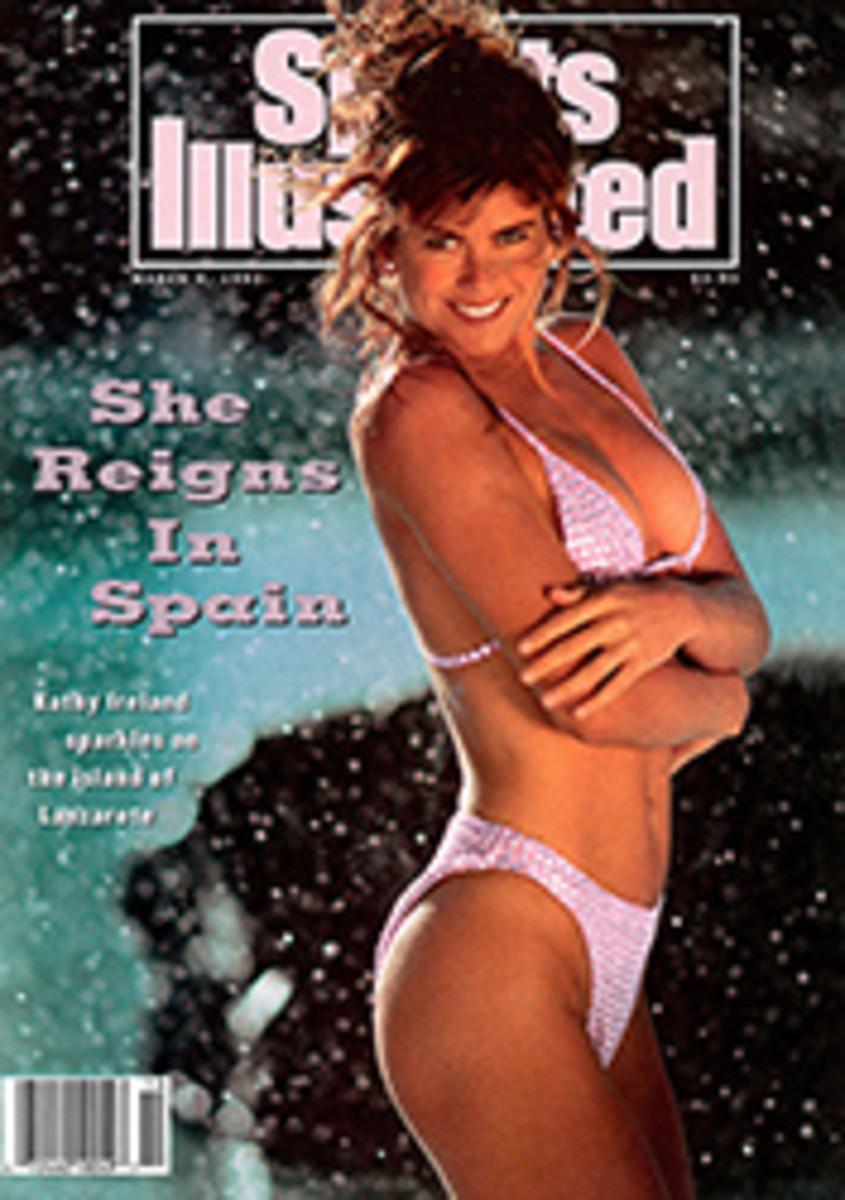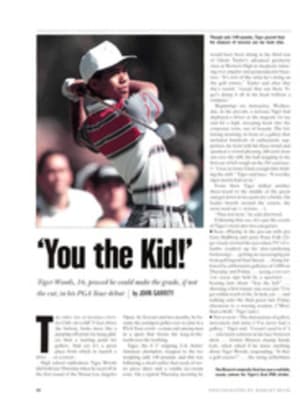
Hoosier Redux
It was 1963, but those who were there still remember the sound of bawling from the locker room that night. Loogootee, fielding the best basketball team in its history and led by Junior Gee, a brash 5'10" senior guard with a Warren Beatty pout, had expected to make its first appearance in the Indiana State high school finals. Instead, Loogootee (pop. 3,100) had been shocked in the opening round of the tournament by bitter rival Washington, 58-51.
Gee went on to become an Indiana all-star, and averaged 11 points per game for a University of Miami team that featured Rick Barry. Still, Gee was haunted by his final high school game.
Now, thanks to a uniquely Indiana phenomenon called Nostalgia Sectionals, Gee and hundreds of former Indiana high school players have been given another chance to drive down memory's free throw lane. Men and women ranging in age from 40 to 90 are rejoining their old teammates and cheering squads from schools such as Epsom, Birdseye, Elnora and Mount Olympus—many long since swallowed up by consolidation—to recreate the tournaments of their past. To the rest of the world it might seem that Hoosier Hysteria has regressed to Dribbling Dementia.
The tournaments are the brainchildren of Tim Nonte, the baseball coach at Princeton (Ind.) High School, who organized the first event in 1988 as a fundraiser to buy lights for the local baseball diamond, Gil Hodges Field. Princeton's 4,500-seat gym was crammed the first night for a 73-30 blowout of the Francisco Owls by the Oakland City Acorns, who went on to win the tournament. "We aren't trying to recapture our youth—just our memories," said Nonte, 49. "It brings together old communities that had lost their identity. It's magical."
The craze has spread throughout Indiana, and Nonte estimates that as many as 20 such tournaments have been held around the state in the past three years. At Washington (pop. 11,325), nearly 15,000 fans attended a weeklong fest in 1990. And last April, the Indiana Basketball Hall of Fame held a four-team regional tournament at New Castle Chrysler High School, which featured former powerhouse teams from Anderson, Muncie Central, Chrysler and Lafayette Jeff.
For one memorable week, Washington's 7,000-seat auditorium was transported back to the future. While long-skirted, letter-sweatered, bobby-soxed women led cheers, players in frayed letter jackets hugged and slapped each other. Pep bands resurrected school songs. Legendary coaches roamed the benches barking substitutions. "Some people think Bobby Knight invented chair-throwing in Indiana," said 44-year-old John Helm, who was a sophomore member of the 1963 Washington team that destroyed Gee's dream. "They don't know what intimidation is unless they played for these high school coaches in the '50s."
Some nostalgia teams held weekly practices in the year preceding the Washington tournament. "Lots of guys lost weight, and there was quite a boom at sporting goods stores," said Nonte. Stunned by the size of the crowds, the players sheepishly emerged from the locker rooms as if they were violating some law of the gods by stepping back into time. But once the games began, old instincts took over and the competition became fierce; the quality of play was often surprisingly good.
"These guys play just as hard as they did in high school," said Bill (Fire Truck) Miley, who dispensed towels and advice as he did in his student manager days for Washington's 1941 state champions. "You should see their bumps and bruises." Coaches also reverted to form: When one opposing player butchered three shots in a row, Washington's Steve Craney, 74, (this writer's father) said, "That kid alone has missed enough to put 'em ahead." That "kid" was 55 years old.
Johnny Walker (Montgomery, class of '61), an insurance salesman, wore his original Chuck Taylor Converse All-Stars. Generations of players hovered around the floor during games, heatedly debating whether the golden age of high school basketball had passed. Charlie Harmon, a member of two state championship teams for Washington in the 1940s and later a third baseman and outfielder for the Cincinnati Reds, St. Louis Cardinals and Philadelphia Phillies, recalled that coaches were not permitted to talk to their players during timeouts. "We were smarter back then," said Harmon. "We had to be. We coached ourselves." Others lamented the lionization of Indiana University's Damon Bailey, who was touted by some in 1990 as the best high school player in the state's history. "There were a lot of players like him in the old days," said Helm, a nursing home administrator who was the leading free throw shooter for his Georgia Southern University team in 1968-69. "Coaches just don't teach the court sense he has anymore."
Teenage cheerleaders watched with both bemusement and awe the routines of their predecessors, who included Washington's Nellie (Spike) Swanagan, 78, the state's first female cheerleader; and St. John's Fred Walker Jr., 54, Loogootee's only cheerleader during the days when the local Catholic bishop banned females from the role. "We're more acrobatic now, but we don't get the crowds participating like they used to," said Stephanie Clifton, a Washington cheerleader, class of '92. Born in an era when organized girls' sports were few, many of the nostalgia cheerleaders were frustrated athletes who threw themselves into the games—sometimes literally. Alfordsville's Georgia Gabhart Prewett ('54), who could palm a basketball, once earned a technical foul for her team when she intentionally tripped a referee, sending him into a belly slide across the floor. "Our principal never reprimanded me, though," she said.
For some schools, these tournaments are family reunions. At the Washington meet, Montgomery's team boasted four Kavanaughs—Albert, Lee and David, all teachers, and Louis, who announced the games on radio. Another brother, Steve, 39, looked forward to exorcising demons of his own in a future nostalgia contest. While celebrating after Montgomery reached the sectional finals in 1971, Steve was dancing an Irish jig atop his car and stumbled. He injured his ankle in the fall, and without him, his team lost the title to Loogootee the next night. "I still have dreams about that game," said Steve. "Maybe I'll come back on crutches so people will remember me." Yet another Kavanaugh brother, Tim, quit playing basketball a few years ago when a man he was guarding during a pickup game dropped dead.
Although the tournaments are played with fun and jocularity, they also serve the need to relive the memories, a need that players such as Helm and Gee admitted was hard to explain to non-Hoosiers. "I could walk down the street and 10,000 people would know me," said Helm. "Maybe I'd know 500 of them."
One can get a sense of how significant this is by considering the case of former Washington broadcaster Joe Edwards. Three generations of players have raced to their car radios on Friday nights to hear his voice immortalize their names in his weekly wrap-ups. The 69-year-old Edwards, retired and living in Florida, was invited back in 1990 to do the play-by-play of the Nostalgia Sectional for one of three stations that broadcast the games. Scheduled for heart surgery, Edwards was warned by doctors that the excitement of the tournament could be dangerous to him. He insisted on going. He broadcast the opening night's session and died of a heart attack the next day.
As for Gee, now a teacher in Florida, he gained a measure of satisfaction at the Washington tournament in 1990. Displaying the same repertoire of behind-the-back passes and cocky canters that had delighted fans and enraged opponents nearly 30 years ago, he and his Loogootee teammates beat Washington and went on to win their Nostalgia Sectional. The team celebrated its victory by posing for the championship team photo that—had the 1963 tournament gone the other way—would have been hanging in the Loogootee gym all these years.
When asked about the rematch with Washington, Gee paused, unable to shake the memories. "I don't know what happened," he said after the game. "I went out there tonight to certain spots on the floor, and I could still see the same images, the same faces—everything."
So could a lot of other Hoosiers.
PHOTO
DAVID E. KLUTHO
At Washington, Lester Stoll (in blue) of Epsom '58 dribbled by Sam Shaw of Shoals '58.
PHOTO
DAVID E. KLUTHO
Petersburg's Rick France topped Elnora's Alan Banks.
PHOTO
DAVID E. KLUTHO
Even the cheerleaders returned for the tournament.
Glen Craney is a writer living in Malibu, Calif. This is his first story for SI.

